Archive for Places to go
February 24, 2008 at 10:36 pm · Filed under Places to go
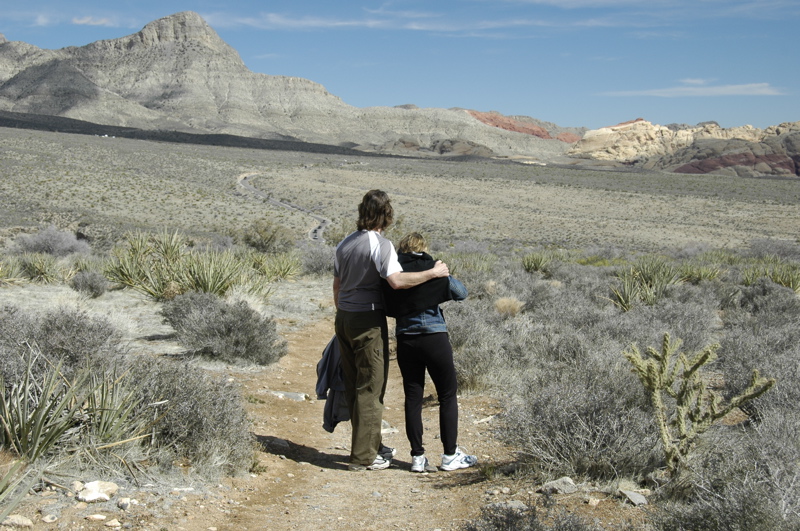
I’m getting behind on the blog because there is so much going on each day. At this point I’m trying to catch up with what we did on Saturday. It’s all becoming a blur of activity.
In the morning I took Adam and Susan up to Red Rocks National Conservation Area, which is in the hills just west of Las Vegas. I’ve wanted to go there for years and for some reason it has never worked out until now.
The Conservation Area is really at the level of a national park. The views and hikes are stunning, and there’s a 13-mile loop drive that gives you a great summary of the place. We did three short hikes, totaling about five miles, and caught a few highlights including the visitor center, some pictographs and a waterfall.
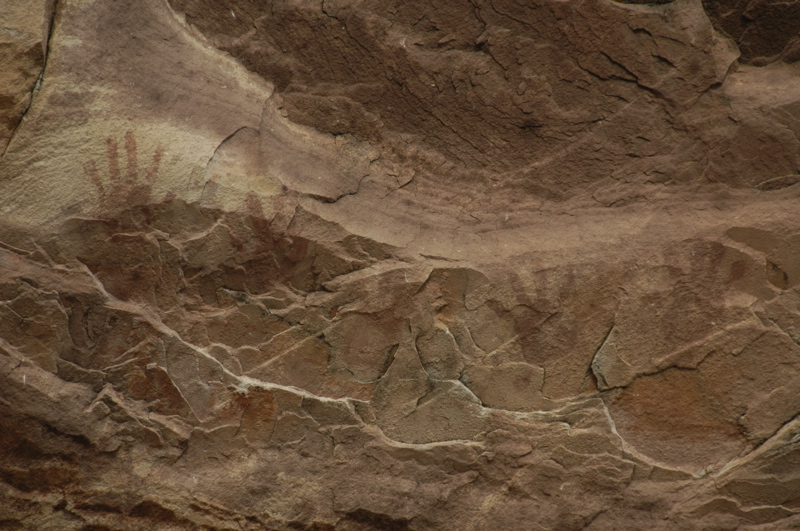 The park was magnificent and the hikes were fun, but in retrospect it was a bit of a mistake to do so much in the early part of the day. I dragged myself back to the house around 5 pm and found Brian & Leigh arising from a nice two-hour nap. So when guests began to arrive at 7 pm for their Saturday night poker game, I was certainly not at the top of my form.
The park was magnificent and the hikes were fun, but in retrospect it was a bit of a mistake to do so much in the early part of the day. I dragged myself back to the house around 5 pm and found Brian & Leigh arising from a nice two-hour nap. So when guests began to arrive at 7 pm for their Saturday night poker game, I was certainly not at the top of my form.
Nonetheless, I survived until midnight and even came out ahead in the game. It was a fun evening with some great people. Four were new to Las Veegas, and two were lifelong residents. One was a pirate/stunt man in the Treasure Island show. One was a reporter for two websites (one his own). It made for a lively night.
At the end of the evening, Leigh and Brian pronounced me fit for the Sunday morning poker tournament. I’ll tell you how that turned out on Monday.
February 23, 2008 at 8:09 pm · Filed under Places to go
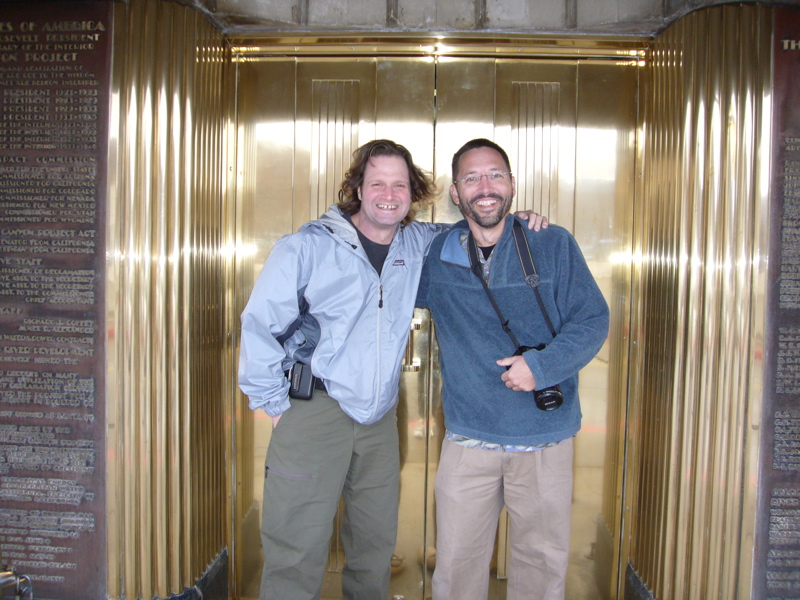 I’ve met up with good Airstream friends Adam and Susan here in Las Vegas. Since Friday turned out to be a quieter day than I expected, I was able to take the afternoon off and go with them to Hoover Dam. It’s only about 30 minutes from Las Vegas.
I’ve met up with good Airstream friends Adam and Susan here in Las Vegas. Since Friday turned out to be a quieter day than I expected, I was able to take the afternoon off and go with them to Hoover Dam. It’s only about 30 minutes from Las Vegas.
I’ve blogged the dam before, and taken the tour, but I have to say that it is a thrill to visit even the second time. Uncharacteristically, Black Canyon (where the dam sits) was filled with low gray clouds and frequent rain. It was still beautiful to see, perhaps even more than usual, with the fog drifting through. I hadn’t noticed before how much of the interior architecture is Art Deco styled, nor that there’s actually a Men’s Room with terrazzo floors built into the top of the dam.
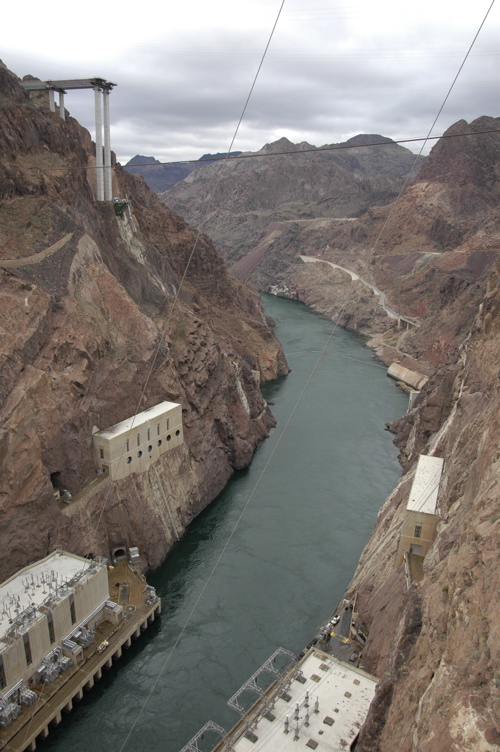 Visually, a lot in this area is beautiful, or at least colorful and interesting. It’s a great place to take pictures. So I’m going to create a new Flickr photo collection for some of the Las Vegas images I’ve captured this week. See it here.
Visually, a lot in this area is beautiful, or at least colorful and interesting. It’s a great place to take pictures. So I’m going to create a new Flickr photo collection for some of the Las Vegas images I’ve captured this week. See it here.
Brian and Leigh have continued to give me some training at poker, and I’m going to give their lessons a test tonight. They have invited about eight people over for a Saturday night “home game”. If I fail, it will be because they didn’t teach me well, and if I succeed it will be because I am brilliant. (Just kidding.) It will actually be just a fun evening with some new people, and Brian and Leigh are excellent teachers regardless.
February 16, 2008 at 11:44 pm · Filed under Places to go
Each year in Patagonia, Arizona, the local library organizes a “Writer’s Roundup”, during which local writers sign books, give short talks, and read from their works. For a tiny town such as Patagonia, which is known to the outside world primarily as a good bird-watching spot, this would at first seem to be a non-starter as an event. After all, how many good writers can there be in the area?
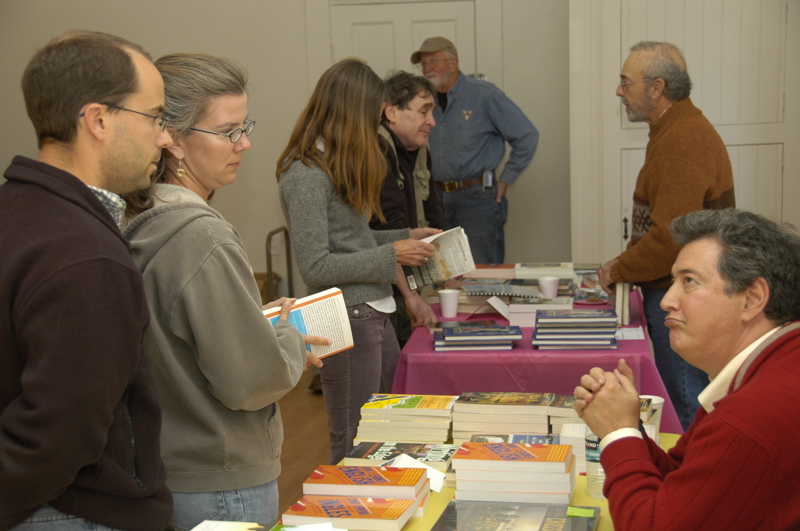 As it turns out, there are many, and a few well recognized names. Just down the street from the library lives Philip Caputo, author of “A Rumor of War,” which was a very important documentary of the Vietnam War from a soldier’s point of view. (He’s wearing a brown sweater in the photo, toward the back.)
As it turns out, there are many, and a few well recognized names. Just down the street from the library lives Philip Caputo, author of “A Rumor of War,” which was a very important documentary of the Vietnam War from a soldier’s point of view. (He’s wearing a brown sweater in the photo, toward the back.)
At the table next to him was Tom Miller, author of “On The Border,” a significant book about the nature of the US-Mexican border. (Talking to Bobby and Danine in the photo.) I bought a signed copy of his book “Trading With The Enemy,” which is about his experiences in Cuba.
“It’s a strange event,” said Tom, speaking of the Writer’s Roundup. The authors are all in a single room with their books arrayed on tables, and they just hang around and chat with anyone who comes by, and sign copies on request. I doubt any of them make enough money from the sales to make it worth their time but nobody seems worried about that. (I believe it is a fundraiser for the library.) Being a small town and a small event, it’s a great opportunity for fans to meet authors without any pretense or barriers.
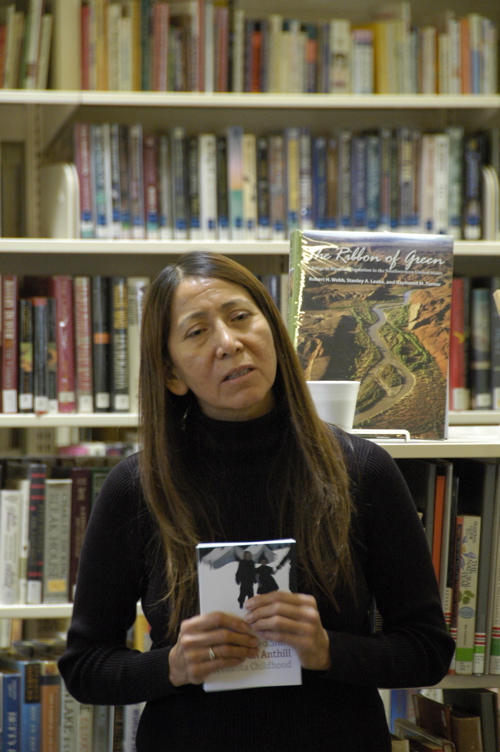 The authors range from well-known to quite obscure, but being opinionated and bright they are all interesting to hear from. We dropped in on Delphine Redshirt’s talk and short reading, in which she explained how she worked to write in her mother’s voice for a book in which she documented some first-person Lakota stories. Delphine also offered some encouragement to would-be authors, which was good to hear since I keep thinking about writing a book someday.
The authors range from well-known to quite obscure, but being opinionated and bright they are all interesting to hear from. We dropped in on Delphine Redshirt’s talk and short reading, in which she explained how she worked to write in her mother’s voice for a book in which she documented some first-person Lakota stories. Delphine also offered some encouragement to would-be authors, which was good to hear since I keep thinking about writing a book someday.
(See more photos from the Writer’s Roundup on our Flickr site.)
We came down to Patagonia at the behest of Dr. C, a good Airstream-owning friend and occasional contributor to Airstream Life magazine and a blog on this site. He and his wife are renting a tiny adobe house in town for the season. The Writer’s Roundup was only an excuse — we really wanted to catch up with the good Doctor and Lynn, who are always interesting and friendly.
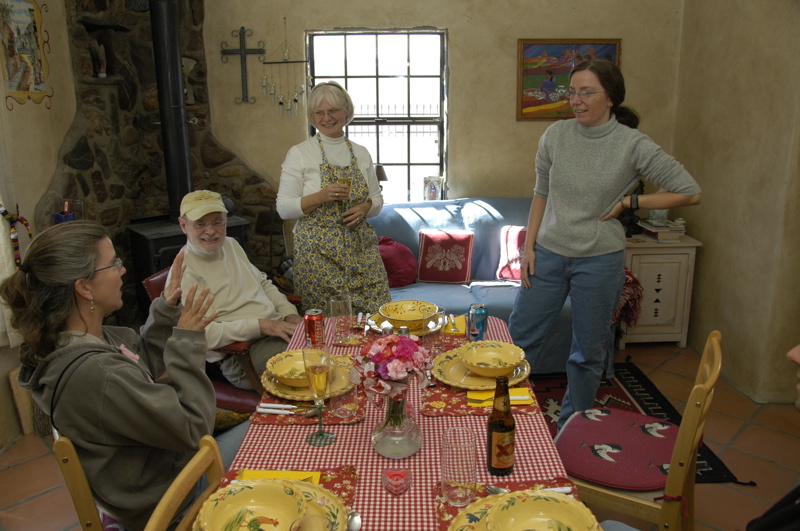
It was a full day. Lynn is into quilting, and wanted to share some of her knowledge with Emma and Elise. I knew that they’d love doing a craft project with Lynn, and sure enough they were completely distracted all afternoon learning how to sew and make little colorful pillows. It was one of those days when the conversation flowed so freely that we didn’t know how to stop. We ended up being in the little adobe house until late evening, before taking the 65 mile drive back up to Tucson.
Bobby & Danine have decided to stay another day. The plan was to depart on Monday, but more interesting things await them in the Tucson area, and they need a bit more time. I thought that might happen, and it’s welcome news. The driveway campground won’t be the same after they leave.
January 22, 2008 at 8:19 pm · Filed under Home base, Places to go
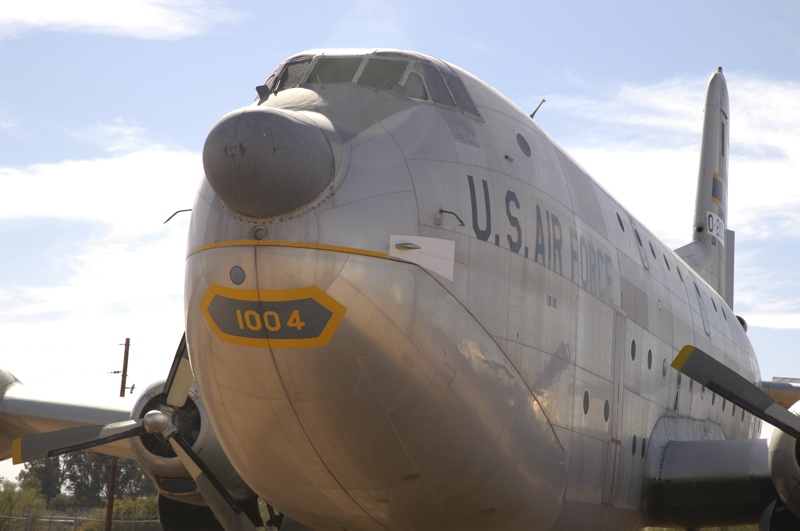
There are a lot of aircraft smiling at the Pima Air & Space Museum, despite the fact that they don’t fly anymore. They must like retirement.
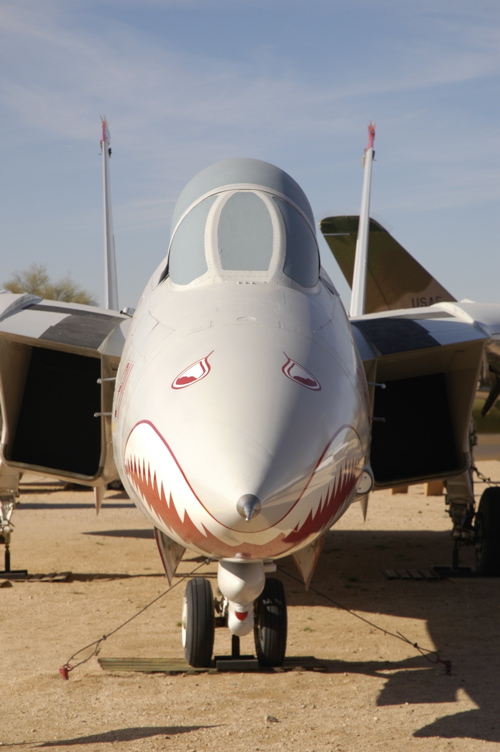
I’ve visited the museum before (see blog entry here) , but with over three hundred aircraft and four major buildings, it deserves a second visit. It’s one of the best aviation museums in the USA.
It’s also a great place to take pictures, and we aren’t the only ones to realize that. Halfway through our visit, 450 photographers from a convention showed up and mobbed the place with enormous cameras, reflectors, and even a couple of models.
Fortunately there’s a lot of acreage for everyone. When the photogs arrived we were about to hop on the bus for the other great attraction associated with PASM: the 309th Aircraft Maintenance and Regeneration Group, better known as “the boneyard.”
You can get a peek at the boneyard for free just by driving up Kolb Blvd in Tucson. But if you want to get a guided tour of the place, it’s an extra $6. Since it is part of an active military facility, there’s an ID check and nobody can get off the bus, but the tour is great. There are hundreds of amazing aircraft to be seen, in seemingly endless rows. Some of them are mothballed for future use, some are being parted out, others (like B-52 bombers) are being chopped up and left in the sun for Russian satellites to observe under the terms of the SALT II agreement.

A fraction of the 309th AMARG — click for larger
The boneyard also has all the dies needed to build B-1B bombers, should the decision ever be made to start production of them again. Those dies alone take up several acres of space. Then there are the rows of F-16s, A-10s, T-37s, F-14s, and a few one-of-a-kind aircraft. For a warbird or aviation geek, it’s a really cool tour. At the end of it, we were grinning like the aircraft.
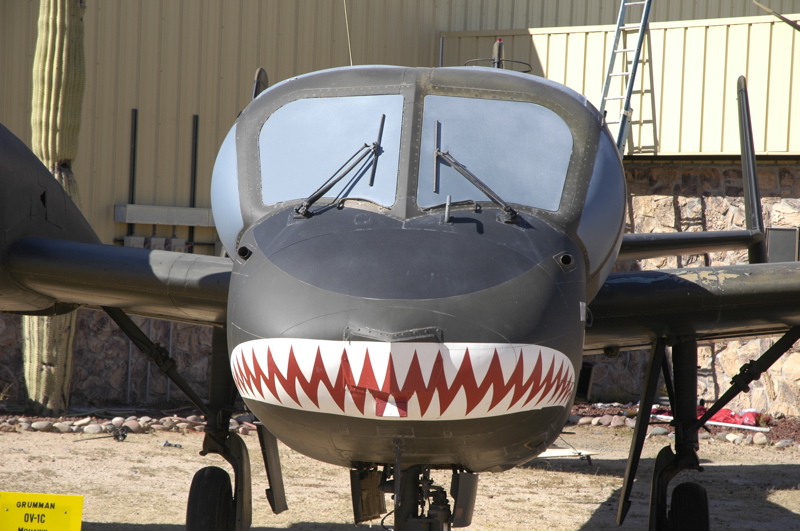
January 21, 2008 at 10:17 pm · Filed under Places to go
Since we are expecting to be residents of this area eventually, we need to figure out the popular sights for our occasional out-of-town guests. Living in Vermont, we accumulated dozens of brochures and guides of things to do in the area, and I bound all of the loose items in a three-ring binder entitled, “There’s Nothing To Do Here.” This proved popular with our occasional visitors, since we only included the good stuff and tried to mix in a lot of lesser-known but fun things based on our years living there.
Brett is our first official house guest, since he is sleeping on an inflatable mattress in the living room, and so he is also our first guinea pig. It is a little tricky advising him on things to see and do here since we have lived here only for about three months in total, and most of that time was spent either looking for a house or fixing it up. But I do know a few good spots near town and I pointed him in the right direction, then followed while he snapped pictures of cactus and canyons.
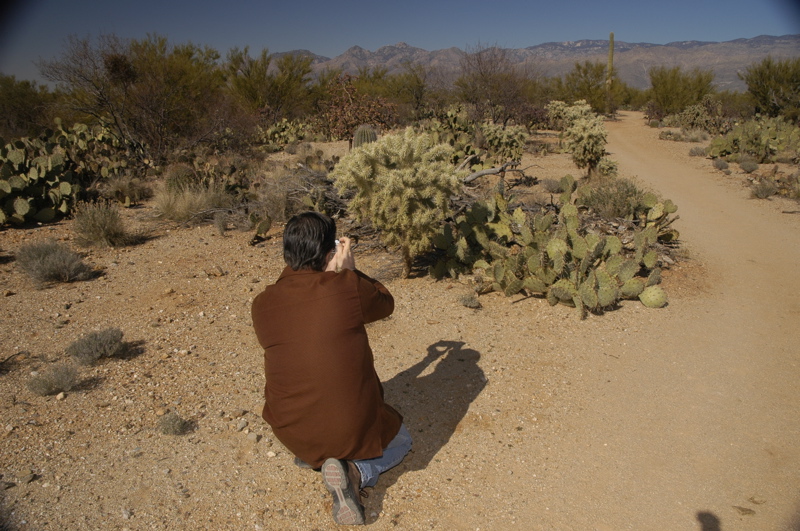
Saguaro National Park is one of the first places I’d point anyone who is interested in the desert. The second place is Sabino Canyon (a national forest site). Both are only a few miles from our house. Above, Brett is learning about the cacti that grow here. That’s a “teddy bear cholla” that he’s photographing. Also in the picture are saguaro, barrel cactus, prickly pear, mesquite trees and palo verde trees.

Sabino Canyon is another outdoor site not to be missed. The road is closed to vehicles but there’s a tram that runs you up the canyon, or you can walk or bicycle. If you have a national parks pass you get admission to both Saguaro NP and Sabino Canyon for free. We arrived after 4:30, too late to take the tram. There are always lots of people walking to road until sunset, so we just joined them and hiked a couple of miles up the canyon before turning back.
The hills around Sabino are filled with saguaro cactus, so many that they form a desert forest. People expecting the desert to look like the Sahara are inevitably surprised at all the things that live here. Along the way if you listen carefully you may hear the soft chuckling and hooting of Gambel’s Quail, an funny little bird with a tuft on its head. They run across the road on tiny feet, hardly ever flying, in small groups. People from out of town often assume they are roadrunners, but roadrunners are much bigger and look completely different.
Sabino Canyon contains a stream that flows much of the year. It was running today, filled with cold water from snow melting high up in the Santa Catalinas. The stream is a reminder that the desert isn’t completely devoid of water, it’s just drier than other areas.
As we walked back down the road after sunset, the full moon rose above the walls of the canyon, which was a nice surprise. From all these experiences, I think that Brett discovered today how beautiful the desert can be. By taking him around to see these places, I’ve also been reminded of the reasons why I’ve been attracted to the desert as well. So having occasional guests to show around is good for us too.

January 15, 2008 at 7:08 pm · Filed under Places to go
Tonight will be my last night in Quartzsite. Six nights has been plenty to get to understand this place, although I can’t claim to have seen everything. It’s a much more complicated picture than I had expected. Quartzsite is not just a spot in the desert that RV’ers claim as their own every winter. It’s not just a phenomenon for retirees. It has a zeitgeist that I have not encountered anywhere else.
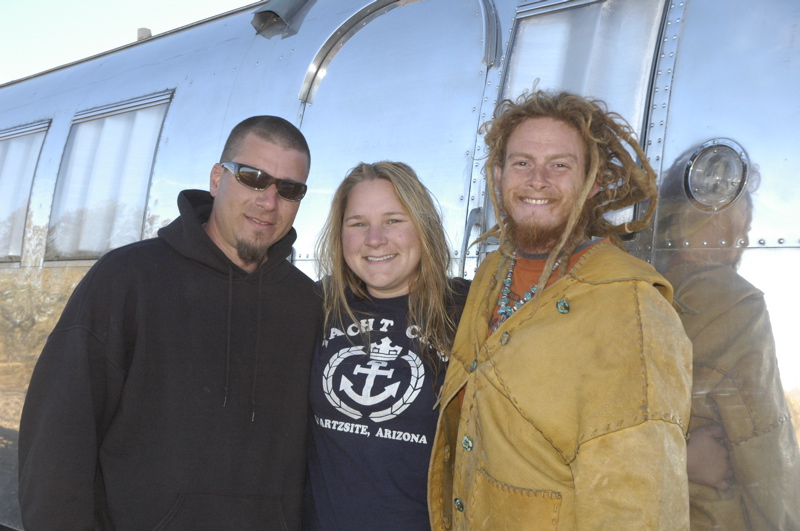
Matt, Carrie, and Jay are good examples of why this is so. They have been coming to Quartzsite for thirteen years. Lately they stay in their 1966 Airstream Overlander in the LTVA, but in prior years they camped in a conversion van for which Carrie hand-built the cabinetry.
They are undoubtedly in the minority among the zillions of retirees who are parked here in their giant triple-axle fifth wheels and half-million-dollar Class A motorhomes, but they contribute a very important part of the overall feeling of Quartzsite nonetheless. They staff the rock shops and add to the culture. They are the folks with the bonfire in the wash at night. They help keep it lively.
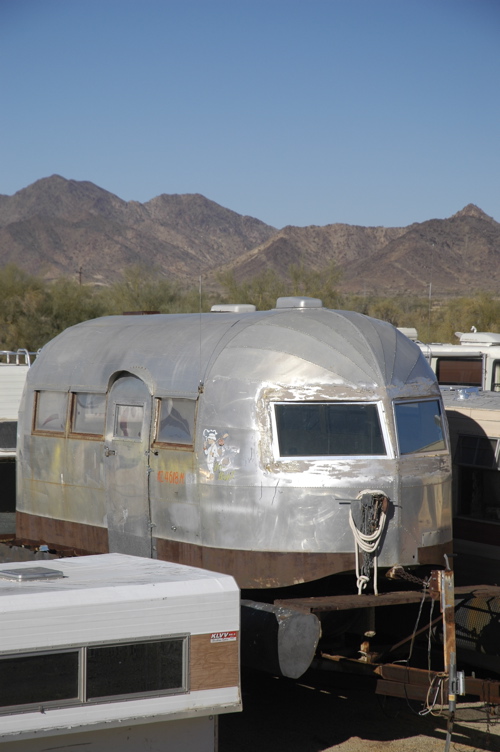 And there’s much more. There’s a guy in town who runs a book shop and wears almost nothing all day (at least when it is warm). He’s a regular tourist attraction in his own right. There’s a pyramid-shaped monument to a Syrian (“Hi Jolly”) who came over here in the 1940s as a camel driver, and stayed the rest of his life. Someone has an aluminum trailer (either a Silver Streak or a Curtis Wright) on floats stored just outside town, and there are other people dry-washing the earth to find gold. Thousands of years ago people pounded mesquite seeds with rocks and you can still see the holes they wore in the stone cliffs. Every one of them has a story.
And there’s much more. There’s a guy in town who runs a book shop and wears almost nothing all day (at least when it is warm). He’s a regular tourist attraction in his own right. There’s a pyramid-shaped monument to a Syrian (“Hi Jolly”) who came over here in the 1940s as a camel driver, and stayed the rest of his life. Someone has an aluminum trailer (either a Silver Streak or a Curtis Wright) on floats stored just outside town, and there are other people dry-washing the earth to find gold. Thousands of years ago people pounded mesquite seeds with rocks and you can still see the holes they wore in the stone cliffs. Every one of them has a story.
Weighed against the diversity of people who are here and who have been here in the past, the thousands of RV’ers who sit indoors and watch TV every night are not the most interesting part of Quartzsite. They are like grains of sand, amongst which a few dazzling diamonds can be found. I’ve had fun finding a few of the diamonds, and if I come back to Quartzsite, it will be to find more.
Solar report: no reading taken at 8 a.m., I was in a rush to get out and photograph Matt, Carrie, and Jay at their trailer before they went to work. At 5 p.m., batteries were at -43 amps, so after six nights of boondocking with full sun most days (and careful conservation), we’re in pretty good shape. The safe useful capacity of our batteries is about 170 amps. I’m also still in good shape on water and holding tanks, which is not a big surprise. Even with three of us in the trailer we can get 4-5 days, so six nights by myself was pretty easy.
January 13, 2008 at 6:56 pm · Filed under Places to go
I came here to research an article about Quartzsite for future publication in Airstream Life magazine, and it is starting to come together. I’ve been looking beyond the flea markets (five major ones), and RV parks (70 of them) that dominate this town, to try to discover the “real” Quartzsite. It’s hard, because the little historic and natural gems of Quartzsite are scattered through the dusty hills like the elusive gold flakes so many people are seeking.

Last night I drove north of town about five miles to the Plomosa Road area, where a lot of people are camping for free (this is BLM land but outside the LTVAs which charge a fee). Mike & Tracy were there in their Airstream 345 Classic motorhome, along with Jim D in his very nice “Squarestream”. These are all folks I’ve met before. After dinner, Mike agreed to show me some of the lesser-known sites today, based on his prior experience with the area, and Jim decided to come along for the ride.
So off we went this morning. I quickly discovered that seeing the sights here requires lots of long drives down dusty back roads, and four-wheel drive is nice to have. Around Quartzsite there are several gold mines, and many more small groups or individuals working pits. We saw plenty of them in remote places. You can still stake a claim, just like in the old west days, and dig a pit for gold, although most people use excavators rather than shovels these days. One such pit we saw was in the middle of a wash. The digging is done and the pit is abandoned. Rather than fill it it, the Corps of Engineers dictated that it be left to fill naturally in the next wet season. So in the meantime it’s an obstacle for the four-wheelers that use the wash as a highway.
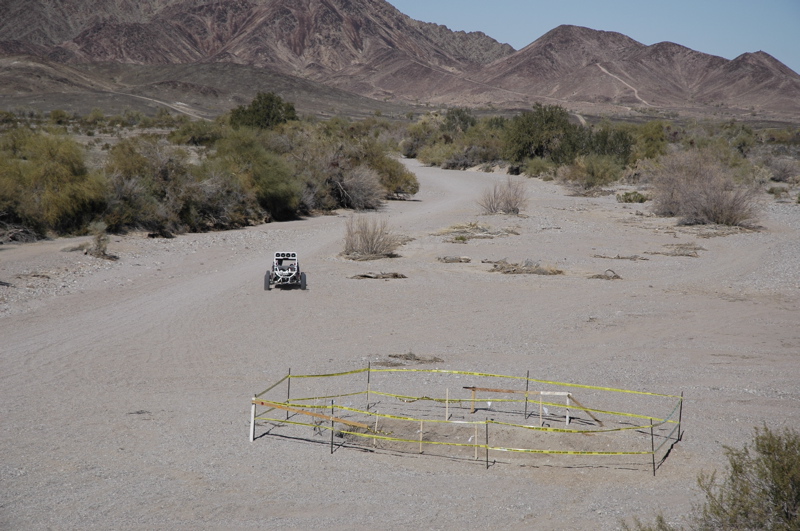
We did find one petroglyph site today and I got photos for the magazine. We also encountered an Airstreamer with a 1965 trailer (a Tradewind perhaps?) and tons of solar panels. He generates more power than he can use, which made me envious since I’m carefully rationing my power this time of year. His tips led us to some metates (ancient Native America grinding and pounding holes) as well.
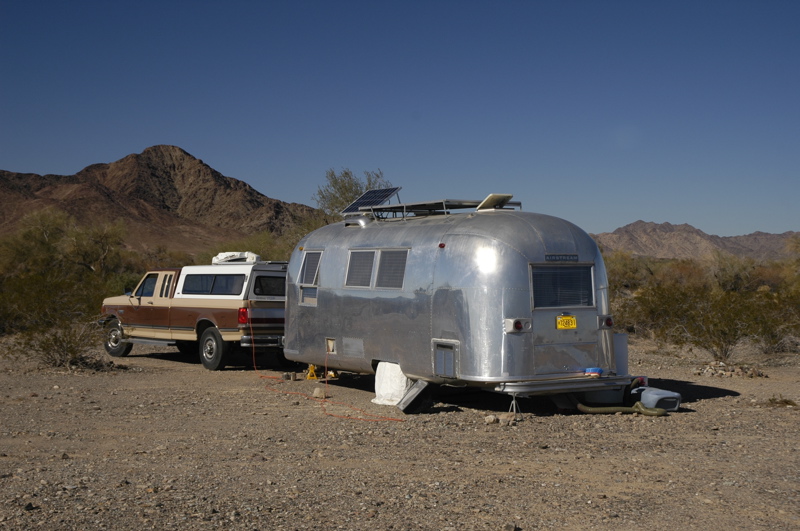
He also told me of a spot where some of General Patton’s tanks can be found abandoned. Patton used this area as a training ground for tanks that he thought might be joining the battle in WW II. I’m going to try to find that spot before I leave.
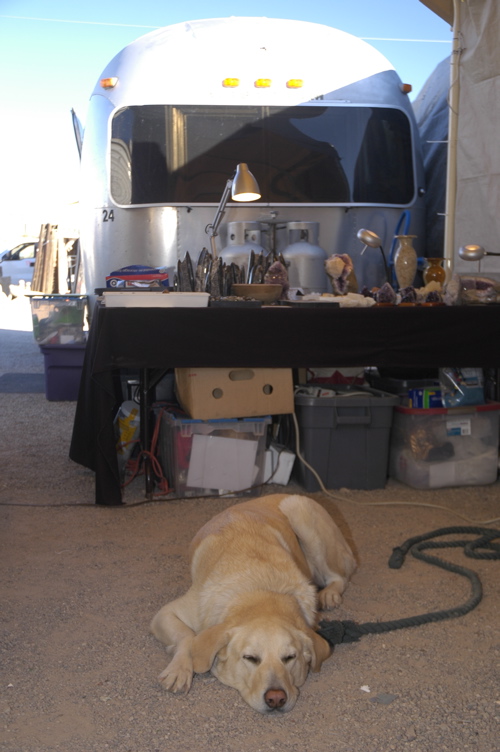
Things are still slow for the vendors. Above, Jake the dog takes a nap at Jim Breitinger’s booth. Nobody is sure why Quartzsite is so “off” this year but many people are claiming that there are only half the participants of prior years. Traffic has been almost nonexistent, whereas in past years there have been backups. You can browse any vendor’s booth for 5 minutes and get their undivided attention. Personally I like the lack of crowds but I feel badly for the vendors who trucked semis full of merchandise and will likely be trucking it forward, virtually unsold, to Tucson for the gem show there.
The past few days have been absolutely calm, but this is unusual for the desert in winter. Today, the normal weather started up: brilliantly clear skies and strong breezes which cause dust devils. My neighbor has a wind generator on his trailer that is spinning madly, and my trailer is rocking in the gusts.
Solar report: As of 8 a.m., batteries were at -68 amps. At 5 p.m., batteries were at -33 amps, for a net gain of 35 amps today. Not bad. This was under completely clear skies. My batteries are still at 80% of their useful capacity after three nights.
I saw a vendor selling a very slick electric panel tilting setup which would be perfect for improving our solar gain, but it was $700, which is a bit expensive for our needs. I’ll wait for the catalytic heater to be installed, and maybe replace a few lights with fluorescents. Cutting power use is much less expensive than trying to increase power generation.
« Previous entries ·
Next entries »
 The park was magnificent and the hikes were fun, but in retrospect it was a bit of a mistake to do so much in the early part of the day. I dragged myself back to the house around 5 pm and found Brian & Leigh arising from a nice two-hour nap. So when guests began to arrive at 7 pm for their Saturday night poker game, I was certainly not at the top of my form.
The park was magnificent and the hikes were fun, but in retrospect it was a bit of a mistake to do so much in the early part of the day. I dragged myself back to the house around 5 pm and found Brian & Leigh arising from a nice two-hour nap. So when guests began to arrive at 7 pm for their Saturday night poker game, I was certainly not at the top of my form.



















